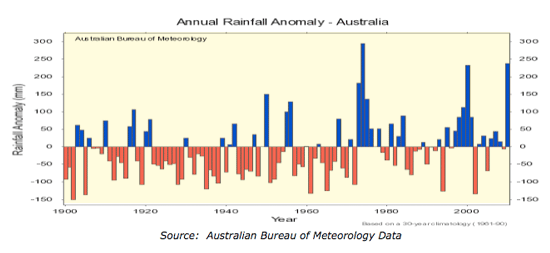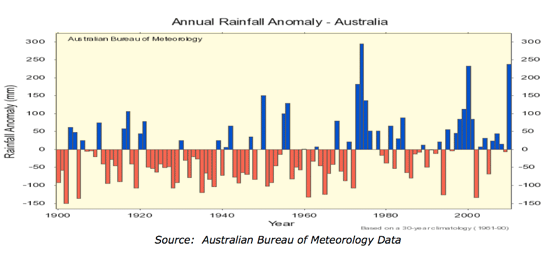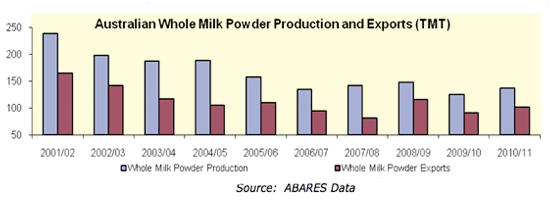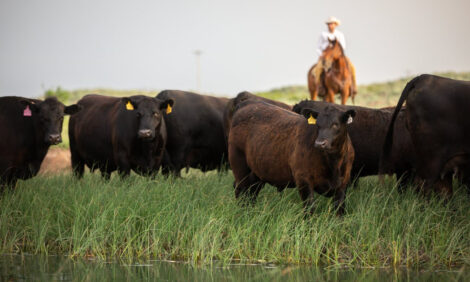



Australia Dairy And Products Semi-Annual 2011
Dairy production and exports are forecast to increase in 2011 as production conditions continue to improve. This represents a turnaround in the long-term decline experienced in the dairy industry since the drought began in 2002, reports the US Foreign Agricultural Service.Summary:
Eastern Australia appears to have fully recovered from the severe and record breaking drought which commenced in CY 2002 and began to end with widespread and soaking rains on Christmas day 2009. CY 2010 has been compared with the legendary rainfall year of 1974 which saw devastating cyclones in northern Australia (Cyclone Tracey) and heavy flooding in southern and eastern Australia.
Flooding in 2010, particularly in the key dairy producing areas of northern Victoria, constrained dairy production below Post’s previous expectations. Normal rainfall conditions have been assumed in CY 2011 and this should see production increase.

Widespread rainfall and flooding has seen irrigation reservoirs completely recharged and this is expected to boost production of fluid milk going forward, particularly in the crucial irrigation areas of northern Victoria and southern NSW. Fodder availability has also improved sharply and, combined with improved pasture conditions, should see milk yield continue to increase.
The greatest constraint to fluid milk production going forward is the shortage of dairy cattle available for herd expansion. This will likely constrain production, at least partially, for 2011 and beyond. Consecutive years of drought have seen the dairy herd fall to its lowest level in memory.
Despite increased domestic supplies of grain, historically high grain prices are also likely to place some constraint on fluid milk production. However, improved supplies of irrigation water are likely to see larger volumes of pasture produced, mostly circumventing the effect of high grain prices.
The Australian dollar recently reached a record high of $US1.10 and this is expected to see growth in exports somewhat constrained in CY 2011. Strong growth in the Australian economy is likely to see domestic consumption continue to grow steadily in CY 2011 and beyond. Imports of US cheese are likely to continue to grow.
Commodities:
Dairy, Milk, FluidDairy, Cheese
Dairy, Butter
Dairy, Dry Whole Milk Powder
Dairy, Milk, Nonfat Dry
Dairy Cow Numbers
Total Cow NumbersDairy cow numbers are forecast to increase to 1.57 million head in CY 2011, up slightly on the estimated 1.55 million head for CY 2010, representing the first substantial increase in cow numbers since CY 2001. Prices received for dairy cows are historically high, driven by a sharp increase in demand as producers seek to increase herd numbers in response to improved seasonal conditions.

Dairy cow numbers have been falling in Australia since 1965, according to historic ABARES figures, as the industry continues to rationalize. The primary reason for falling cow numbers has been a decline in dairy farms and increased cow productivity levels. Over time, the total number of farms has continued to fall dragging total cow numbers lower despite the continued increase in herd sizes of remaining dairy farms.
While it is possible for cow numbers to increase sharply, dairy cow numbers are expected to rise steadily going forward. Industry sources urge caution in regards to the potential for increases in cow numbers. Falling farm numbers, milk price discounting and competition for land and labor from other industries are expected to continue to slow the growth in total cow numbers for the foreseeable future. ABARES expects improved fodder supply and pasture conditions to see modest consecutive increases in cow numbers out to 2014/15.
Traditionally, Australian dairy farms have been located adjacent to large urban populations in capital cities on the coast. However, as urban development has increased, producers have sold their land and relocated to larger regional holdings in inland Australia. Technology advances in irrigation and transport have aided this relocation. Many producers selling farms have opted to retire and exit the industry and this has seen farm numbers fall.
Fluid milk production for CY 2011 is forecast to increase to 9.6 MMT and represents the first increase in fluid milk supply since CY 2002. A continued increase in milk yield per cow is expected to see production increase, assisted somewhat by a small increase in cow numbers.

Despite the forecast increase in fluid milk production in CY 2011 to 9.6 MMT (9.32 billion liters), this level would be considered well below the historical average.
Fluid milk production for CY 2010 has been revised downwards to 9.33 MMT, below the 9.4 MMT previously reported by Post. Despite improved irrigation water supplies previously expected to lift production, persistent heavy rainfall combined with flooding in the worst affected areas prevented increases in fluid milk production previously expected by Post. Industry sources suggest these conditions effectively limited access to pasture and created shortages of pelletized fodder commonly fed indoors.
Australia purports to have the only deregulated dairy industry in the world. However, since deregulation in CY 2001, the pricing of fresh milk at the retail level has been controversial. Accusations of large retailers unsustainably discounting retail milk to the detriment of farm gate prices persist and have been very loud in CY 2011.
Coles Supermarkets, Australia’s second largest retailer, recently implemented a new national pricing policy. This policy has effectively discounted retail prices for meat, seafood, dairy, deli and bakery products and has seen milk sold for as little as AUS$1 per liter in Coles supermarkets. This compares to double the price for “branded” milk.
This new policy has drawn negative reaction from the Australian dairy industry and has received much media attention. Serious concerns were raised that the pricing strategy was unsustainable and anti-competitive.
The issue was referred to a Senate Committee in February 2011. The Committee has received 151 submissions and has held public hearings. The committee has recommended that “the government table a formal response to the recommendations outlined in the previous Senate Committee Inquiry into dairy pricing” (conducted in CY 2010) before further recommendations can be made. http://www.aph.gov.au/senate/committee/economics_ctte/dairy_industry_supermarket_2011/interim_report/report.pdf
Cheese production for CY 2011 is forecast at 328 TMT, up around three percent on the revised estimate for the previous year. This increase is roughly in-line with the forecast increase in fluid milk supply.
Estimated production for CY 2010 has been revised downwards to 319 TMT in line with up-to-date industry data. An unforeseen shortfall in the supply of fluid milk due to flooding and heavy rain is likely to have constrained cheese production in CY 2010. According to ABARES reports, stronger demand for other dairy commodities (such as milk powders) is likely to have encouraged the production of other dairy commodities.

Exports of cheese for CY 2011 are forecast to increase around three percent to 170 TMT in line with forecast increases in production. Imports of cheese from the United States increased again in CY 2010 driven by a stronger Australian dollar and strong demand from the food service sector. Industry sources report a large Australian pizza chain recently switching to US cheese for pizza production.
Dairy, ButterTotal butter production for CY 2011 is forecast to increase to 111 TMT in line with increased fluid milk supply. Estimated production for CY 2010 has been revised downwards slightly to 108 TMT in line with up-to-date industry data

Exports are forecast at 66 TMT, up on the revised estimate for the previous year. Historically, butter production has tended to decline over time in line with consumer demand, exports however have tended to fluctuate more widely.
Dairy, Whole Milk PowderWhole milk powder (WMP) production is expected to increase around three percent in CY 2011 following large increases in CY 2010. The recent large increases appear to be slowing in CY 2011, according to monthly industry production data.

Exports for WMP are also forecast to grow around three percent in CY 2011, despite the large upward revision for exports in CY 2010. A record high value for the Australian dollar, which recently reached $US1.10, is expected to cool export demand in CY 2011 and this is expected to see both production and exports of WMP fall.
Dairy, Nonfat, Dry – Skim Milk PowderSkim milk powder (SMP) production is forecast to increase around three percent in CY 2011 to 230 TMT. This increase remains well below the revised estimated increase for CY 2010. Improved milk supply is expected to be partially offset by more subdued export demand and this is expected to see production increases in the region of three percent.

Exports of SMP in CY 2011 are expected to increase around three percent in line with increases in production. Larger export volumes are expected to be constrained by the record high value of the Australian dollar at time of writing this report. Exports for CY 2010 have been revised upwards.
June 2011

